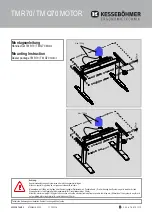
6
Maintenance and service guide - LSPX-FLSPX ZONE
21 - Ex tb – LSES-FLSES ZONE
22 - Ex tc
5725 en - 2020.02 / c
2 - STORAGE
Prior to commissioning, motors should be stored:
- in a dry location, in their original packaging and protected
from moisture: for relative humidities in excess of 90% the
insulation may fall off very rapidly and around 100% may be
practically zero. Monitor the condition of the rust prevention
protection of unpainted parts. Storage conditions can be
between -40°C and +80°C. For storage in an environment at
between -40°C and -20°C: avoid impacts with the motor
(damage due to the impact resistance of the equipment at
these temperatures).
For very long period storage the motor may be packaged in a
sealed envelope (e.g. thermo-welded plastic) with desiccator
packs inside:
- protected from large and frequent temperature variations in
order to prevent condensation. During the storage periods only
drain plugs should be removed to eliminate condensation
water.
- if the area is subject to vibration, try to reduce the effect of this
vibration by placing the motor on a damping support (rubber
plate or similar).
- turn the rotor a fraction of a turn once a fortnight to prevent the
bearing rings from becoming marked.
- do not remove the rotor locking device (if there are roller
bearings).
Even if the motor has been stored in the correct conditions,
certain checks must be carried out before it is started up:
Greasing
- Motors equipped with permanently greased bearings:
Maximum storage period: 2 years. After this time, replace the
bearings.
-
Motors equipped with bearings that can be re-greased:
Storage
period
Less than 2
years
The motor may be commissioned if the
recommendations indicated in § 3 are
followed to the letter.
More than
2 years
Bearings must be replaced and bearing
housings (or flanges) must be cleaned
and degreased in order to renew the
grease entirely, in accordance with the
information shown on the nameplate
(quantity and type of grease).
Replace shaft passage seals and for
IP66 motors recess seals before starting.
Greases used by LEROY-SOMER:
See nameplates.
Warning! Do not carry out the high voltage test
on auxiliaries.
In the event of the machine being re-painted, the
thickness of the coat must not exceed 2 mm and
0.2 mm for IIC group equipment. Otherwise it must be
anti-static irrespective of its thickness if the motor is II
3G and II 3D.
3 - COMMISSIONING
Before starting users are responsible for checking that the
equipment, the gas (and if relevant dust) group and conditions
of use are compatible.
In all cases, compatibility of the motor and its environ-
ment must be guaranteed before its installation and
also throughout its life.
Electric motors are industrial products.
THEY must therefore be installed by
qualified, experienced and authorized personnel. The
safety of people, animals and property must be
ensured when fitting the motors into machines (please
refer to current standards).
3.1 - Protocol for lubrication during
commissioning
Given the “pot” storage lives stated by oil companies and the
transport and storage conditions, the rotation systems of all
motors must be subject to enhanced monitoring during the first
week of operation.
The aim of this monitoring is to ensure that an oil film is formed
on the bearing tracks, thus ensuring optimum operation of the
rotation system. Finally, this means that on the one hand
personnel can become familiar with the operation of the
equipment and on the other hand allows any teething troubles
associated with the installation to be identified.
The amount of grease indicated for re-greasing on the
nameplate must be added when topping-up with grease.
Greases must not be mixed. Grease used for top-ups must be
that stated on the nameplate.
If mixed accidentally, bearing housings (or flanges) must be
removed and fully cleaned and degreased, and the bearings
must be changed.
In specific terms, the operations to be carried out during
installation are as follows:
• Before installing the motor, top-up with grease and
rotate the motor by hand for ten or so turns.
• After starting the motor (10 min), top up with grease.
• After 24 hours continuous operation, top up with grease.
• After an operating period of 100 to 200 hours, top up with
grease.
• During this starting period (up to 50 hours operation
after the last top up) there must be intensive monitoring.
The bearing housing temperatures and vibration must
be measured frequently.
This data is to be retained by operators. It represents a
database and history which will be useful for future maintenance.
INSTALLATION AND MAINTENANCE - LSPX-FLSPX ZONE 21 - Ex tb – LSES-FLSES ZONE 22 - Ex tc
Содержание LEROY-SOMER FLSES 100 L
Страница 49: ...49 Maintenance and service guide LSPX FLSPX ZONE 21 Ex tb LSES FLSES ZONE 22 Ex tc 5725 en 2020 02 c NOTES...
Страница 50: ...50 Maintenance and service guide LSPX FLSPX ZONE 21 Ex tb LSES FLSES ZONE 22 Ex tc 5725 en 2020 02 c NOTES...
Страница 51: ...51 Maintenance and service guide LSPX FLSPX ZONE 21 Ex tb LSES FLSES ZONE 22 Ex tc 5725 en 2020 02 c NOTES...







































